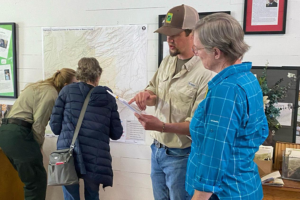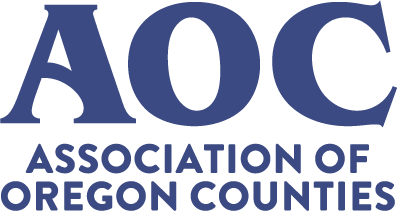
Oct 29, 2024 | AOC Business Partner
Sponsored content contributed by AOC Business Partner: iSector
Oregon’s rural communities face long standing challenges in seizing economic opportunities and maintaining the capacity to manage critical public services. Despite the availability of unprecedented federal, state, and philanthropic resources, many rural cities and counties lack the infrastructure and expertise to navigate complex funding systems and implement vital projects, such as water and wastewater improvements or affordable housing initiatives.
The 2024 NW Rural Investment Strategy Summit, part of a broader initiative to address these gaps, brought together over 450 participants from across Oregon, including leaders from philanthropy, financial institutions, nonprofits, and state and federal agencies. The summit’s goal was clear: to develop a strategy ensuring that historic federal investments not only flow into rural Oregon but also catalyze sustainable, long-term growth in these underserved areas.
One of the key outcomes of this ongoing effort is the creation of the Oregon Rural Investment Strategy Partnership. This partnership, a collaboration between iSector, USDA Rural Development, the Association of Oregon Counties, League of Oregon Cities, foundations, and representatives of Oregon Business, aims to design a co-investment framework that aligns public, private, and philanthropic resources for rural communities. The goal is to enhance local capacity, provide technical assistance, and ensure that communities can access and manage the resources they need to thrive.
A pivotal next step that is under construction is the development of a hub or center for technical expertise and resource coordination. Working with organizations that serve rural Oregon, this could support rural cities and counties by providing access to project managers, public works, and planning professionals to assist with essential infrastructure and community development needs. To further accelerate on-the-ground action, it could also include a Community Leverage Fund which could enable cities and counties to offer incentives for collaborative, multi-sector projects.
The Summit and these ongoing initiatives underscore the importance of rural communities to Oregon’s economic future. By building the capacity of these regions and fostering collaboration, we can help them seize opportunities that will sustain their resilience and growth for years to come.
To learn more visit https://isector.org/partnerships/rural-investment-strategy-risp/.
For any questions or to connect with us, please email rural@isector.org.

Sep 24, 2024 | AOC Business Partner
Sponsored content contributed by AOC Business Partner: Metro West Ambulance
Emergency! Help, Call 911! We all hope to never need an ambulance for ourselves or loved ones. Let’s be frank, when it comes to ambulances, most of us just don’t want to think about it. Right up until one is needed at the worst moment in our lives. At Metro West Ambulance and our Family of Companies we are incredibly proud to be the trusted EMT’s and Paramedics multiple counties have chosen to answer calls for help in communities across Oregon 24 hours a day, every day.
As the largest provider of rural emergency medical services and ambulance transport in Oregon we provide access to sophisticated emergency care, as well as behind the scenes but we also provide critically important hospital to hospital transport, critical care transport, and wheelchair transportation. Metro West Ambulance may well be the provider in your community. Our Family of Companies has grown since its’ beginning 71 years ago in Washington County. Through the years we’ve welcomed Medix Ambulance, Clatsop County; Pacific West Ambulance, Lincoln County; Woodburn Ambulance, Marion County; Mid-Valley Ambulance, Lane County; Umpqua Valley Ambulance, Douglas; Bay Cities Ambulance, Coos County, and our newest addition, Pioneer Ambulance, Baker County. All a part of our second generation Oregon family owned business.
Together these companies responded to over 100,000 calls for service last year alone. That is a tremendous contribution to the patients we serve and health care systems of Oregon. While many of these were emergencies that needed life-saving care immediately, many others were moves from one hospital to another for specialized care, or wheelchair transportation for a disabled US Veteran needing to get to an essential medical appointment. Our medics provide hospital at home services and one of our locations operates a non-emergency medical transportation brokerage. We partner with county health departments and others to provide vaccinations and other procedures. Just a few examples of our range of services. Each essential for patients to get the care they need.
Accomplishing this is no easy task. Of course we need facilities and equipment. Most importantly we need highly trained, committed and compassionate employees. An experienced leadership team ties it all together.
Each ambulance is an approximately $300,000 emergency room on wheels including medical equipment and supplies such as self-loading stretchers to prevent back injuries, cardiac monitors, external pace makers, hospital ventilators, life-saving drugs, and mechanical CPR devices just to name a few. Our three dispatch centers are all tied together and share IT infrastructure and data allowing us to coordinate activities and conduct quality assurance with data from every patient encounter system wide. We have clinical oversight from our Physician Medical Directors at each company who are assisted by training officers.
Each company, whether it is Bay Cities Ambulance in Coos County, Pioneer Ambulance in Baker County, or any of the others, operates independently with a local manager who has broad latitude to make decisions appropriate for their community. Metro West provides support for these local mangers in four key areas; patient billing, finance, information technology, and payroll/benefits coordination. Decisions about specialized equipment or medications to carry, staffing levels, and unique training needs for example are made locally. County Commissioners and the Ambulance Service Area Plans they regulate are the glue that holds these systems together.
Metro West and the whole Family of Companies are proud that as a family owned business we do all this without tax support. All of our hundreds of employees, whether they be EMT, Paramedic, Nurse, Dispatcher, or Administrative, wake up every day ready to answer the next call for help.
Contributed by: Shawn Baird, Metro West Ambulance

Aug 30, 2024 | AOC Business Partner
Sponsored content contributed by AOC Business Partner: Hinge Health
Hinge Health offers customized and more convenient approach to treat joint and muscle pain. Unlike traditional programs, Hinge Health uses technology to give you a personalized plan, live feedback during exercises, and a team of dedicated experts to support you every step of the way. And the benefits don’t
stop there!
Join Hinge Health by enrolling at hinge.health/cisoregon-newsletter2
Join over 800,000 members who have experienced an average of 68%* reduction in pain and gotten back to doing what they love with the Hinge Health program.
Questions? Hinge Health is here to help!
To talk to a member of the Hinge Health support team, call 1-855-902-2777 or email help@hingehealth.com.
*Participants with chronic knee and back pain after 12 weeks. Bailey, et al. Digital Care for Chronic Musculoskeletal Pain: 10,000 Participant Longitudinal Cohort Study. JMIR. (2020)
Participants must be 18+ and enrolled in a CIS Oregon medical plan administered by Regence BlueCross BlueShield of Oregon. Regence BlueCross BlueShield of Oregon is an Independent Licensee of the Blue Cross and Blue Shield Association. Hinge Health® is a separate and independent company that provides services for CIS members enrolled in a CIS Benefits medical plan administered by Regence.

Aug 30, 2024 | AOC Business Partner
(The Sunset Valley Fire burned agricultural fields south of The Dalles in July 2021. Photo by Jacob Powell)
Sponsored content contributed by AOC Business Partner: OSU Extension Service
Wasco County has been designated as “very high risk” for wildfire, making it a higher risk than 95-100% of other communities in the United States.
Because of this, Kayla Bordelon, the Oregon State University Extension Service regional fire specialist for the Willamette Valley and north Cascades, made Wasco a top priority.
And that is not just talk: Bordelon and other local and regional collaborators have been awarded a nearly $6 million grant for the county through the federal Bipartisan Infrastructure Law, which designated a $1.5 billion investment into wildland firefighting and wildfire resilience.
“Building this funding proposal was definitely a labor of love for the handful of us on the grant writing team,” said Bordelon.
Bordelon is a member of OSU Extension’s Fire Program, created in 2019 to support community and landscape wildfire resiliency across Oregon. She joined the team in 2022 after completing a Ph.D. in environmental science with a focus on fire education from University of Idaho.
A substantial component of the grant funding will create and fund a full-time, countywide wildfire coordinator position with Wasco County. “One of my long-term goals is to build local capacity to coordinate wildfire resilience efforts in the nine counties I serve,” said Bordelon. “My number one priority for this grant was funding this county coordinator position. Investing in people allows us to do more work together.”
The rest of the funding will be spread among several sub-awardees including Wasco County Planning Department, the Oregon Department of Forestry, and OSU Extension and includes projects such as creating defensible space around homes to clearing roadside vegetation that is susceptible to sparking or carrying wildfire.
OSU Extension will lead a project to complete a fuels and forest health assessment of 80,000 acres of private, non-industrial forestland in the county. (Fuel is any material that burns in a fire. In the forest, fuel is vegetation such as grasses, shrubs and trees.)
In this assessment, Bordelon said they will be asking questions like: “What species composition is here? Is it healthy? Is it over-stocked with fuels? Do we have a lot of dead and down fuels on the ground?” This information will help identify areas that need restoration and management. “We can look across this whole landscape and say: Wow, we have this many acres of forestland that are high priority for restoration,” she said.
Since this level of detail is not common for private land “it gives landowners more personalized information about management options while also providing county wildfire practitioners with a widespread picture of forest conditions,” Bordelon said.
With that knowledge, county partners are better prepared to ask for state and federal funding. “We will have a really good sense of exactly what needs to be done and where,” said Bordelon. “That makes us more competitive for federal and state dollars.”
Welcoming community
On her first trip to southern Wasco County, Bordelon described how enthusiastic and welcoming the community was. “I went to the town of Wamic, super small town, population 52 to support a community meeting and gather community input on fire resiliency priorities,” Bordelon said. “I showed up hours before the meeting because I wanted to be prepared and didn’t know what to expect.”
When she walked inside, she found “a dozen or more people in The Grange kitchen making lunch for a huge crowd.”
“Community members wanted to be helpful,” she said. The turnout for the meeting ended up being over 100 — doubling the town’s population. “I was very heartened by the engagement.”
Looking forward, Bordelon is working to get similar grants for the other counties she serves. Because of its high-risk status, Wasco County was “an obvious place to start for me, but Wasco is also just the beginning,” she said.
Bordelon’s goal is to help strengthen the counties she works with, so they are best prepared for wildfire before it happens. “In many rural areas, fire departments and wildfire agencies are understaffed or are run by volunteers” she said. “They don’t always have the capacity to write and manage federal grants. By building a coalition and doing it together, we help everyone out.”
See more stories from OSU Extension: https://extension.oregonstate.edu/impact
Contributed by: Henry Carnell | OSU Extension Communications Specialist

Residents attend wildfire input meeting in Wamic in 2023. (Photo by Kayla Bordelon)

Aug 14, 2024 | AOC Business Partner
Sponsored content contributed by AOC Business Partner: GOBHI
Greater Oregon Behavioral Health, Inc. (GOBHI) will host the inaugural Peer Workforce Conference at Eastern Oregon University in La Grande, Aug. 22-23, 2024. This year’s theme, “Holistic Wellness & Self-Care,” promises to offer a rich array of content designed specifically for peer support specialists. A peer support specialist (PSS) is a mental health professional who has personal experience with mental health conditions, substance use disorders, or psychological trauma and is trained to help others who are struggling with similar challenges. Their personal experience and professional training give them expertise that can’t be replicated by professional training alone. PSSs act as role models for clients and can provide a level of acceptance, understanding and validation that may not be found in other professional relationships.
Over the course of two days, attendees will have access to 16 tailored workshops, keynote speakers, and an Eastern Oregon Peer Panel, all focused on the unique needs of peer support specialists who work and live in Eastern Oregon. This conference provides a valuable opportunity for the 140 employed peer workers across Eastern Oregon Coordinated Care Organization’s 12-county region to gather, network, and strengthen their skills.
Participants will benefit from professional development opportunities, social connections with like-minded individuals, and the chance to develop and enhance their skills. The diverse perspectives shared at the conference will foster greater understanding and support for the inclusion of peer support specialists across various organizations in Eastern Oregon. Workshops and panels include topics like: Vicarious Trauma, Behavioral Activation – Practical Tools for Peers Working with Older Adults, Practical Tools & Strategies for Working with Latino Populations, Situational Awareness & Resiliency, and many more.
The overarching goal of the 2024 Eastern Oregon Peer Workforce Conference is to advance the peer support profession and promote its integration into healthcare and community systems throughout the region.
For more information and to register, visit the conference website. Follow the conversation on social media with the hashtag #EOPeers2024.

Jul 23, 2024 | AOC Business Partner
Sponsored content contributed by AOC Business Partner: Regence
Be sure to stay hydrated and keep kids hydrated. Never leave kids or pets in the car on a hot day, even for a short time. Check up on the older people in your life every couple of days during a heat wave to ensure they are staying cool and hydrated.
What is heat exhaustion?
Heat exhaustion occurs when you are exposed to high temperatures, particularly when combined with high humidity. Signs and symptoms can develop suddenly or over time, especially with prolonged periods of exercise. Heat exhaustion symptoms include:
- Moist skin with goosebumps when in the heat
- Heavy sweating
- Dizziness
- Fatigue
- Weak, rapid pulse
- Muscle cramps
- Headache
- Fainting (passing out)
If you experience symptoms of heat exhaustion, stop all activity and rest. Find a cool place for your body to cool down and drink cool water. Heat exhaustion, if left untreated, can progress to heat stroke.
What is heat stroke?
Heat stroke occurs when your body overheats, usually due to extended exposure to or physical effort in hot temperatures. Heat stroke can happen when the body’s temperature rises rapidly and the body is unable to cool down with sweating. Heat stroke symptoms include:
- Altered mental state or behavior, such as confusion and slurred speech
- High body temperature (103°F or higher)
- Hot, red, dry or damp skin
- Nausea and vomiting
- Rapid breathing
- Racing heart rate
- Headache
- Dizziness
- Losing consciousness (passing out)
If you or someone you know starts experiencing symptoms of heat stroke, seek medical attention immediately.
How to stay safe in the heat
While heat exhaustion and heat stroke are serious conditions, they are also preventable. Keep these tips in mind to stay safe in hot weather:
- Avoid exercising outside during the hottest part of the day, typically between 11 a.m. and 3 p.m. Instead, plan your outdoor activities in the early morning hours or late evening to avoid unnecessary heat exposure.
- Drink plenty of water. The average adult needs 3 to 4 liters of water each day — that’s 12 8-oz glasses. During periods of excessive heat, plan to drink more than that as your body dehydrates more rapidly.
- Limit alcohol intake. Alcohol can affect the body’s ability to regulate its temperature.
- Wear loose-fitting, lightweight clothing. Heavy or tight clothing can prevent sweat from evaporating easily, so the body won’t cool down.
- Take steps to keep your home cool. This can include keeping your windows and doors closed during the day to prevent the heat from coming in. Try to avoid using the oven when you’re cooking. If you don’t have air conditioning, you can still keep cool with a fan to circulate the air.
- Use sunscreen and other protective measures to avoid sunburn.







